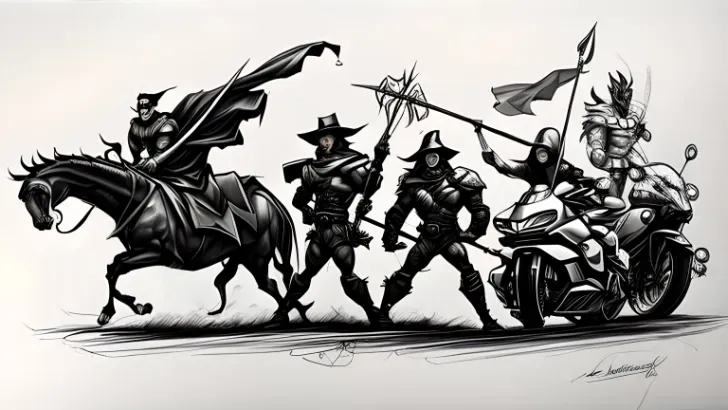
Pencil sketch, cartoon characters, characters introduction sketch, five main characters on scene, action adventure cartoon, super power characters, --ar 3:2
"Write a Text to Image Prompt to Generate a Perfect Image with an AI" is a process of using pre-trained AI models to generate images from text prompts. These AIs have been trained on large datasets of images and text, and have learned to generate images that match text descriptions.
By providing a detailed and accurate text prompt, individuals can use pre-trained AIs to generate high-quality images that meet their specific requirements. This process can be useful for a wide range of applications, including design, art, and visualization.
The key to generating an image using this process is to provide a text prompt that accurately describes the image you want to generate. This may involve describing the objects, colors, textures, and layout of the image in detail, and may require knowledge of the specific pre-trained AI you are using.
Overall, using pre-trained AI models to generate images from text prompts is an exciting and innovative way to create high-quality images that meet specific requirements. With a little practice and experimentation, anyone can learn to write effective text prompts and generate perfect images with AI.
1. Choosing a Pre-Trained AI Model
Choosing a pre-trained AI is an important step in writing a text-to-image prompt to generate a perfect image with AI. There are several AIs available that can generate images from text prompts, each with its own strengths and limitations.
Here are some factors to consider when choosing a pre-trained AI model.
Quality of the Generated Images
One of the most important factors to consider when choosing an AI is the quality of the generated images. You should review examples of images generated by the AI to ensure that they meet your requirements and are of high quality.
Capability to Handle your Specific Task
Different AIs may have different capabilities when it comes to handling specific tasks or types of images. For example, some AIs may be better suited for generating realistic images of objects, while others may be better suited for generating abstract or surreal images.
Ease of use
The ease of use of the AI is also an important factor to consider. Some AIs may have a user-friendly interface that makes it easy to input text prompts and generate images, while others may require more technical expertise to use.
Availability and Cost
Finally, you should consider the availability and cost of the AI. Some AIs may be available for free or at a low cost, while others may be more expensive or require a subscription.
By considering these factors and reviewing the available AIs, you can choose the AI that best meets your requirements and is most suitable for your specific task.
2. Familiarizing yourself with the AI's Capabilities
Familiarizing yourself with the AI's capabilities is an important step when using pre-trained AIs to generate images from text prompts. Each AI has its own set of capabilities and limitations, which can affect the quality of the generated images and the types of prompts that the AI can effectively handle.
Here are some ways to familiarize yourself with the capabilities of the pre-trained AI you have chosen.
Review Examples
One of the best ways to get a sense of what the AI is capable of is to review examples of images generated by the AI. This can help you understand the types of images that the AI can generate and the level of detail and realism that it can achieve.
Read Documentation
The documentation for the AI can provide valuable information about its capabilities, as well as tips for optimizing your prompts to get the best results. You should take the time to read through the documentation and familiarize yourself with the AI's features and limitations.
Experiment with Different Prompts
To get a better sense of the types of prompts that the AI can effectively handle, you should experiment with different prompts and review the resulting images. This can help you understand how specific words and phrases affect the generated images and help you refine your prompts to get better results.
Seek out online Resources
Finally, there are many online resources available that can help you familiarize yourself with the capabilities of AIs. For example, online forums and communities may offer tips and advice for working with specific AIs, while tutorials and guides can provide step-by-step instructions for generating images from text prompts.
By taking the time to familiarize yourself with the capabilities of the AI you have chosen, you can optimize your prompts and generate high-quality images that meet your specific requirements.
A testing prompt a beautiful {nationality} girl, off shoulder white top, face and shoulders in photo, looking at the viewer, portrait shot, ultra detail, sharp focus, in a studio, studio background, studio lighting, professional photographic, 16k (generated multiple images replacing the {nationality} with Afghan, African, American, Brazilian, Chinese, Indian, Indonesian, Iranian, Japanese , Mexican, Russian, and Sri Lankan)
 |
 |
 |
 |
 |
 |
 |
 |
 |
 |
 |
 |












3. Creating a Text Prompt
Creating a text prompt is a critical step in generating an image with AI using pre-trained models. The text prompt is essentially a written description of the image you want the AI to generate. Here are some tips on creating an effective text prompt.
Be Specific
When creating a text prompt, it is essential to be as specific as possible. The more specific your prompt is, the more likely it is for the AI to generate an image that meets your requirements. For example, instead of asking for a "sunset", you could ask for a "colorful, tropical sunset over the ocean with palm trees in the foreground".
Use Descriptive Language
Use descriptive language to convey the image you want to generate. This can include using specific colors, textures, shapes, and sizes to paint a picture of the image in the AI's mind. This can help the AI better understand your prompt and generate a more accurate image.
Consider Context
When creating a text prompt, it is important to consider the context in which the image will be used. For example, if the image is to be used in a marketing campaign, the prompt should be tailored to the target audience and the brand's messaging.
Avoid Ambiguity
Avoid using language that is open to interpretation or could be interpreted in multiple ways. This can lead to an image that does not meet your requirements. Be clear and concise in your language to ensure that the AI generates the image you want.
Experiment with Different Prompts
Experiment with different prompts to see which ones generate the best results. Try varying the language, level of specificity, and context to see which prompts lead to the most accurate and high-quality images.
By creating an effective text prompt, you can help the AI generate an image that meets your requirements and is of the highest possible quality.
4. Formatting the Text Prompt
Formatting the text prompt is an important step in generating a perfect image with an AI using pre-trained models. Proper formatting can help ensure that the AI understands your prompt correctly and generates an image that meets your requirements.
Here are some tips on formatting your text prompt.
Use Natural Language
When formatting your text prompt, it is important to use natural language. This means writing the prompt as you would speak it, using complete sentences and proper grammar. This can help the AI better understand your prompt and generate a more accurate image.
Use Specific Keywords
Use specific keywords in your prompt to help the AI understand the key elements of the image you want to generate. For example, if you want the AI to generate an image of a red apple, use the words "red" and "apple" in your prompt.
Use Punctuation
Use punctuation to help break up your prompt into logical sections. This can make it easier for the AI to understand the different elements of the image you want to generate.
Use Capitalization
Use capitalization to emphasize specific words in your prompt. This can help the AI to better understand the key elements of the image you want to generate.
Avoid using Abbreviations
Avoid using abbreviations or acronyms in your prompt, as the AI may not understand them. Instead, use the full word or phrase to ensure that the AI understands your prompt correctly.
Keep it Simple
Keep your prompt simple and straightforward. Avoid using overly complicated language or syntax that may confuse the AI.
By properly formatting your text prompt, you can help the AI generate an image that meets your requirements and is of the highest possible quality.
5. Submitting the Text Prompt
Submitting the text prompt is the final step in generating an image with an AI using pre-trained models. Once you have chosen a pre-trained A, familiarized yourself with its capabilities, created a text prompt, and formatted it correctly, it is time to submit the prompt and generate the image. Here are some tips on submitting your text prompt.
Follow the AI's Instructions
Different AIs may have different instructions for submitting a text prompt. Make sure to carefully read the instructions provided by the AI before submitting your prompt.
Double-check your Prompt
Before submitting your prompt, double-check it for errors or inconsistencies. Make sure that it is clear and easy to understand, and that it accurately conveys the image you want the AI to generate.
Submit the Prompt
Once you are satisfied with your prompt, submit it to the AI as instructed. This may involve pasting the prompt into a text box or uploading a text file.
Wait for the Image to Generate
After submitting your prompt, you will need to wait for the AI to generate the image. The amount of time this takes can vary depending on the complexity of your prompt and the capabilities of the AI.
Evaluate the Generated Image
Once the AI has generated the image, evaluate it to determine whether it meets your requirements. If it does not, you may need to revise your prompt and resubmit it.
By following these tips and submitting your text prompt correctly, you can help ensure that the AI generates a image that meets your requirements and is of the highest possible quality.
6. Reviewing the Generated Image
Reviewing the generated image is an important step in generating an image with an AI using pre-trained models. Here are some steps on how to review the generated image.
Compare it to your Text Prompt
Start by comparing the generated image to the text prompt you submitted. Make sure that the image accurately reflects the elements of the prompt and meets your requirements.
Check for Quality
Look closely at the image to check for quality issues such as blurriness, pixelation, or distortion. Make sure that the image is clear and high-quality.
Check for Accuracy
Check that the generated image accurately reflects the key elements of the text prompt. For example, if the prompt was for a red apple, make sure that the generated image is indeed an image of a red apple.
Check for Realism
Determine if the generated image looks realistic or if there are any obvious signs that it was generated by an AI. Look for details such as lighting, shadows, and texture to help determine how realistic the image is.
Check for Creativity
Determine if the generated image is creative and original. Consider whether the image meets your expectations and whether it provides a fresh perspective on the elements in your prompt.
Adjust and Repeat
If the generated image does not meet your requirements, consider adjusting your text prompt and resubmitting it to the AI. Repeat the process until you are satisfied with the generated image.
By reviewing the generated image carefully and considering these factors, you can ensure that the AI has generated an image that meets your requirements and is of high quality.
7. Conclusion
In conclusion, generating a perfect image with an AI using pre-trained models involves several important steps, including choosing the right model, familiarizing yourself with its capabilities, creating a text prompt, formatting the prompt correctly, submitting it to the model, and reviewing the generated image. By following these steps, you can generate high-quality, realistic, and creative images that accurately reflect the elements of your text prompt. It is important to note that each AI may have its own specific requirements and limitations, so it is essential to research and understand the model you choose to use. With practice and experience, you can develop the skills to create effective prompts and generate high-quality images using pre-trained AI models.